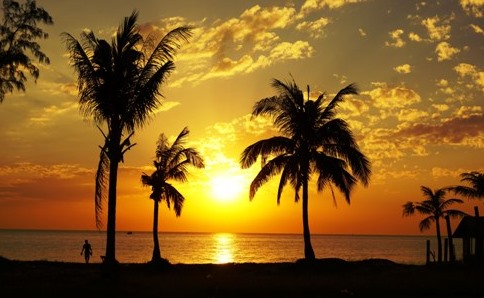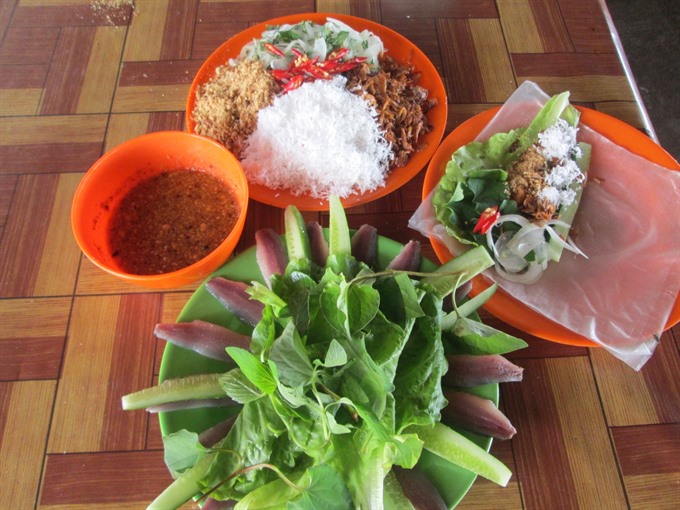Viet Nam News
With turquoise seas, spectacular sunsets and lush rainforests, Phu Quoc Island provides tourists with an unbeatable combination of silky white sand, great hospitality and tasty cuisine. Bo Xuan Hiep reports.
After my recent trip to Phu Quoc Island in Kien Giang Province, I realised I had been far too enamored of internationally famous beaches like Bali, Phuket and the Maldives.
Phu Quoc was right in my backyard, not far from my home in HCM City, and I had overlooked it.
“Fringed with white-sand beaches and with large tracts still cloaked in dense, tropical jungle, Phu Quoc rapidly morphed from a sleepy island backwater to a must-visit beach escape for Western expats and sun-seeking tourists,” says the Lonely Planet, the travel guidebook used by millions worldwide.
“Beyond the resorts lining Long Beach and development beginning on the east coast, there’s still ample room for exploration and escaping.” So true!
Located 45 kilometres from the mainland and a 45-minute flight from HCM City, the island’s forests, white sandy beaches, coral reefs, and diverse flora and fauna continue to draw both local and foreign tourists.
The largest island in the country, Phu Quoc is also the site of an infamous prison used during the wars in Viet Nam.
But, beware. Despite its laid-back vibe, many hotels, resorts and roads are being built at a rapid pace, so visit soon before the hordes of sand and sun-seekers arrive.
As a fan of the ocean, I love nothing more than spending an entire day on the island’s beaches, with occasional dips in the sea.
Which beach is the most beautiful? If you ask a local, the reply is always Sao Beach.
 |
| Orange skies: Dinh Cau Temple is a good spot for visitors to view the island’s spectacular sunsets. VNS Photo Bo Xuan Hiep |
I’ve visited many famous beaches in Viet Nam, including My Khe in Da Nang, Cua Dai in Hoi An, Nha Trang’s seaside, and Mui Ne in Binh Thuan Province.
But, to me, Sao Beach is the most stunning of all. With the island’s ongoing development, however, this tranquil beach might not remain Viet Nam’s best-kept secret for long.
Besides beach lounging, many other attractions are available, but, let’s face it, the ocean remains the main draw, and the spectacular sunsets are a close second.
My favourite lookout spots for the island’s renowned sunsets are along Long Beach and the cliffs by Dinh Cau Temple, a famous destination. The small temple, located a few metres away from the Dinh Cau night market, is built on a mass of rocks.
If you tire of the beach, take a tour of a fish sauce factory. The island is well known worldwide for its aromatic sauce.
Phu Quoc is best discovered on a motorbike, as it gives you freedom to go where you want. As you drive, I recommend that you find an abandoned beach, look for wild monkeys jumping from tree to tree, and visit a remote village.
The possibilities are endless, including kayaking and snorkeling to look at coral reefs. But if you explore on your own, make sure you have a map in hand.
When it comes to cuisine, Phu Quoc offers a fabulous range of fresh seafood. Dining at a night market can be an unforgettable experience. After the sun sets, visit the Dinh Cau Night Market and feast on your favourite seafood all night long.
The market, open daily from 5pm to 11pm, is a popular venue for shopping, drinks and fresh seafood. Don’t miss local favourites like grilled oysters, scallop kebabs and steamed lemongrass crab.
A visit to some of the island’s lovely sights such as Suoi Thanh Waterfall is also recommended. The waterfall, one of the two largest on the island, is located on the road between Ham Ninh and Duong Dong.
 |
| Night life: The Dinh Cau Night Market is a popular venue for shopping, drinking and dining on fresh seafood. VNS Photo Bo Xuan Hiep |
It’s best to visit from May to September, but even during the off-season it’s still worth a stop. At the weekend, it can get busy because many locals visit the nearby park.
To reach the waterfall, drive a bit deeper into the forest for around 15 minutes. On the way, you can stop and swim in icy-cold natural streams or take a picnic.
In addition to leisure activities, you should spend time visiting the former Cay Dua (Coconut Tree) Prison near the village of An Thoi in the southern area of the island.
The prison was used during the First and the Second Indochina wars. During the American war, about 40,000 war prisoners were held and tortured there. You can see instruments of torture, including the “tiger cages”, in some of the barracks.
To learn more about Vietnamese history, stop by the War Memorial as well as Coi Nguon Museum, located near Long Beach. It depicts the history of the island as well as its flora and fauna.
The museum, which has a restaurant, gift shop and a resort nearby, covers four floors and has a nice rooftop with a view of Duong Dong and the coast. The paintings, artifacts and other works of art date back to the 15th century.
Seafood speciality
Before the trip, I was told to try the island’s speciality goi ca trich (herring salad), which I had never had. Thanks to a local recommendation, I got to know Nguyen Hoang Thanh, 54, the owner of a family-run eatery specialising in the dish.
Since herring can be found year-round, the dish “is always fresh”, he said.
Thanh explained the preparation process to me. First, the herring’s scales are scraped and the fish washed clean. It is then sliced thinly and marinated in lime juice for 15 minutes. Later, the slices are squeezed dry.
 |
| Rustic special: Goi ca trich (herring salad) is one of the specialities of Phu Quoc. Once considered a rustic dish, it is now offered by most restaurants on the island. VNS Photo Bo Xuan Hiep |
Other ingredients include chillis, fried onions, peanuts and dried coconut. Herbs collected in the forest and homemade rice paper complete the picture. One or two slices of the herring, topped with the other ingredients, are placed on the rice paper, which is then rolled carefully.
At the thought of eating raw fish, the wonders of sushi notwithstanding, I thought I would have to hold my nose as I tried my first-ever goi ca trich.
But to my delight there was nothing smelly about the dish, which is served with Phu Quoc fish sauce containing chillis, garlic, crushed peanuts, sugar and lime juice.
Once considered a rustic dish, the herring speciality is offered by most of the island’s restaurants, and might just become another brand name product for Phu Quoc.
Tourism potential
This year, Phu Quoc Island hopes to welcome more than 1.8 million tourists, an increase of nearly 26 per cent compared to last year. Local authorities are targeting a 43 per cent increase in the number of international arrivals to more than 300,000.
Tourism revenue is also expected to jump this year to more than VND11.15 trillion (US$493.4 million), a 25 per cent increase over last year.
To achieve the target, the island district plans to run promotions and offer more tourism products, Huynh Quang Hung, vice chairman of the district’s People’s Committee, has said.
Cultural and historical relic sites, as well as natural attractions and the environment, will be more closely managed as well.
To attract tourists, flights to Da Lat and international destinations will begin this year, and traditional local festivals will be celebrated year-round.
Hung said the district would also begin to closely monitor prices and quality of transport, accommodation and food services.
In recent years, the island has become a magnet for property developers because of its favourable policies aimed at turning the island into a “tourist paradise”, with 150 kilometres of coastline and forest covering 62 per cent of its area.
Nguyen Thanh Tung, deputy head of the Phu Quoc Island management board for investment and development, said the island was offering investors incentives that would promote high-end projects.
Around 167 of 220 proposed projects have been licensed, with 30 of them worth a total of VND31 trillion ($1.36 billion) already in operation, according to Mai Van Huynh, vice chairman of the People’s Committee of Kien Giang Province.
Last year, the island welcomed more than 1.45 million tourists, a year-on-year increase of 63 per cent, with foreign visitors accounting for 38.5 per cent to 201,130. They spent more than VND8.92 trillion ($394.35 million).
Getting there
To reach the island, the best way is to fly. Vietnam Airlines, Vietjet and Jetstar all offer flights. During peak season, direct flights can be taken from HCM City, Ha Noi, Can Tho, Rach Gia and Da Lat as well as from Russia, South Korea, China, Sweden, Denmark, the UK and Australia, with more routes to be added soon.
Tourists can also take a ferry from Ha Tien Town and Rach Gia directly to Phu Quoc, and once there, can travel around the island by bicycle, car, jeep, taxi or motorbike.
Beaches, good food, stunning sunsets, and much more await your arrival! VNS